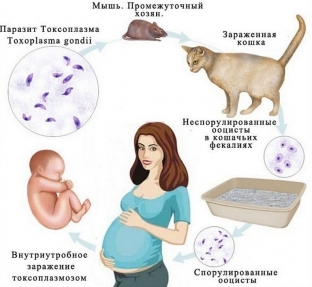Among all the diseases and pathological conditions that can develop during pregnancy, TORCH infections form a special group. The group of these infections is especially dangerous, since their development during pregnancy can cause miscarriage, or the development of severe congenital pathologies in the fetus. One such infection is toxoplasmosis, which is caused by protozoa in animals and humans. A feature of this infection is its long-term asymptomatic carriage, which is observed in approximately 30% of women of reproductive age. Why is toxoplasmosis so dangerous during pregnancy - read on estet-portal.com.
What is the danger of toxoplasmosis during pregnancy: complications of infection
Laboratory blood tests of women for infection with infections from the TORCH group are performed when the expectant mother first visits the antenatal clinic. Ideally, such studies should be carried out several months before the planned pregnancy. This pathology is not very common, about 6 out of 1000 pregnant women become infected with toxoplasmosis during pregnancy. But the severity of the complications that arise as a result of such infection makes this figure very frightening. Therefore, it is so important to diagnose this infectious disease in a timely manner.
Toxoplasmosis during pregnancy:
- how does toxoplasmosis occur during pregnancy;
- complications of toxoplasmosis during pregnancy: fetal malformations;
- methods for diagnosing toxoplasmosis: serological tests.
How does toxoplasmosis occur during pregnancy
Toxoplasmosis during pregnancy is caused by the obligate intracellular parasite Toxoplasma gondii. Animals carry the infection, which is especially important, since cats can infect a future mother with toxoplasmosis from domestic animals. The parasite multiplies in the intestinal cells of cats and is released into the environment along with their feces. A woman can get toxoplasmosis in several ways:
- directly through cat feces that contain toxoplasma oocysts;
- through meat that contains toxoplasma cysts and has undergone insufficient heat treatment;
- by transfusion of contaminated blood;
- rarely by ingestion of contaminated food or water.

Complications of toxoplasmosis during pregnancy: fetal malformations
Toxoplasmosis during pregnancy can have serious consequences for the fetus. If the infection occurred before pregnancy, the fetus is not infected. But if the primary infection occurs during pregnancy, the risk of infection of the fetus increases in accordance with its duration. When infected with toxoplasmosis in the first trimester of pregnancy, the risk of infection of the fetus is 15%, in the second - 25%, in the third - 60%. Infection in the first trimester or just before pregnancy often leads to spontaneous abortion. Congenital toxoplasmosis in infants presents with chorioretinitis, micro- or hydrocephalus, calcification, and severe brain damage. But it is important to remember that most newborns with congenital toxoplasmosis do not have symptoms of the disease,
Methods for diagnosing toxoplasmosis: serological testsDiagnosis of toxoplasmosis during pregnancy is based on laboratory tests, namely serological tests. The main method for diagnosing toxoplasmosis today is a serological test for antibodies to toxoplasmosis. The most common are the Sabin-Feldman test, agglutination and indirect hemagglutination tests, indirect immunofluorescence and complement-fixing antibodies. The determination of specific lgG antibodies in the blood of a pregnant woman indicates that the infection occurred before pregnancy. The absence of antibodies to toxoplasma is a poor prognostic sign, as it confirms the likelihood of infection with toxoplasmosis during pregnancy. Preventive measures should be taken against such women.
Prevention and treatment of toxoplasmosis: how to protect the unborn child






Add a comment